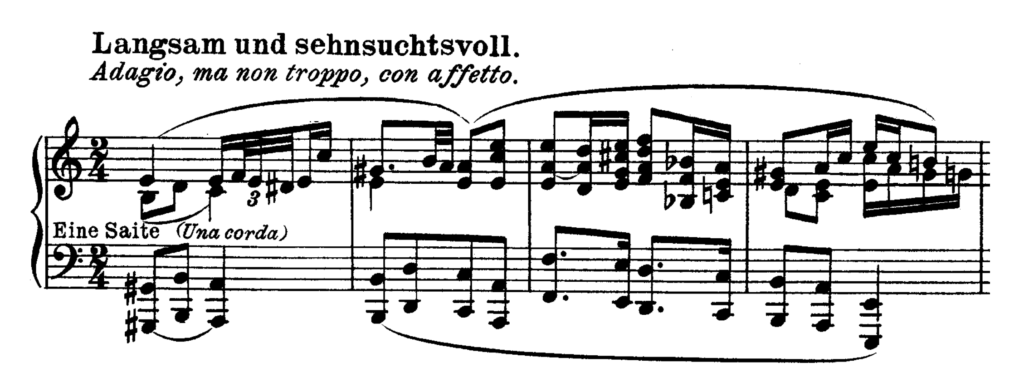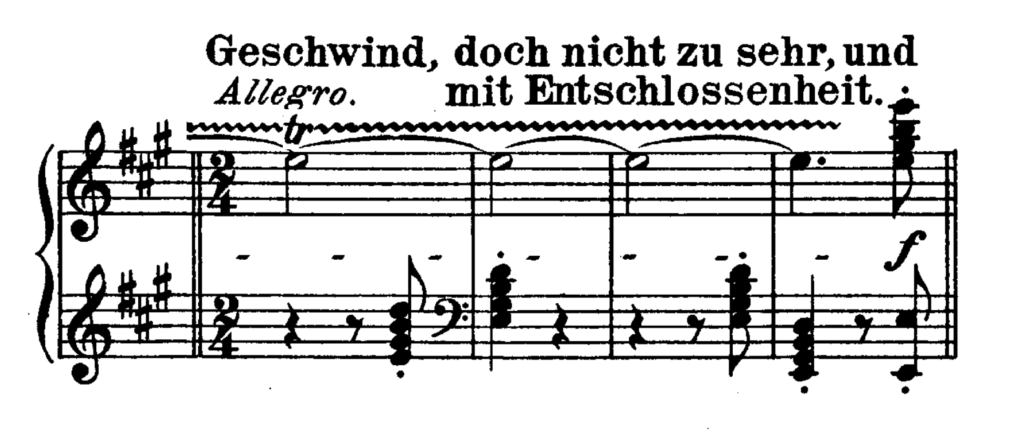Analysis
Contents
For the benefit of all pianists learning this work, we present to you a concise and easy to use analysis of Beethoven’s Piano Sonata No.25 in G major.
First Movement (Allegro Ma Non Troppo)
Form: Sonata Form. A Major.
EXPOSITION:
Bars 1-4: First Subject in A major (tonic). The first subject consists of only four bars, Bars 1-4, beginning and ending upon the dominant. Note the appearance of the first subject in the introduction to the finale.
Bars 5-16: Connecting Episode. The connecting episode begins with a repetition of the first two bars of the first subject, after which it is in the dominant key throughout; the initial figure of the second subject is foreshadowed, beginning at Bar 9. It ends with interrupted cadence.
Bars 16-25: Second Subject in E major. The second subject, which is like a continuation of the episode, commences with a four-bar phrase, Bars 16-20, followed by a five-bar phrase, Bars 20-25. Out of the nine bars forming the second subject, six of them, Bars 19-25, are constructed entirely upon tonic and dominant harmony of E major.
Bars 25-33: Coda. The Coda begins with four bars of tonic and dominant harmony in E major, after which there is a double pedal point.
DEVELOPMENT:
Bars 35-55: The development, after two bars of the chord of the dominant, commences with several references to the first subject, Bars 35-42, after which the first three notes of Bar 2 are considerably developed.
RECAPITULATION:
Bars 55-57: First Subject (shortened) in original key. Only a fragment of the first subject re-appears here, and this is varied and transposed to tonic minor key.
Bars 58-68: Connecting Episode. The original connecting episode is altered, Bars 59-60, but Bars 60-68 are the same as Bars 8-16, slightly varied, and transposed into tonic key.
Bars 68-77: Second Subject in A major (tonic). The second subject (transposed into tonic key) is slightly altered at Bar 76, probably because of the limited compass of the keyboard in Beethoven’s time.
Bars 77-End: Coda. The Coda is elongated at Bar 85. At Bars 98-99 there is a reference to the second subject, which is inverted, Bars 99-100.
Second Movement (Vivace Alla Marcia)
Form: Ternary Form. F Major.
This movement evidently takes the place of the Scherzo.
FIRST PART:
The First Part is in Simple Binary Form. The bass of Bars 1-8 proceeds chromatically (though not in the same octave) from F down to F sharp (with the exception of B natural).
Bars 1-9: First Subject in F major (tonic), ending in C major (dominant). The first subject (which is repeated) modulates to, and ends in, the dominant.
Double bar and repeat.
Bars 10-13: Coda, ending in tonic key. Bar 9 is repeated at Bar 11 (an octave higher) and at Bars 12-13 in the key of F (tonic).
Bars 14-37: Development. The development commences with a figure from Bars 2-3 used in imitation. At Bars 17-19 a new figure is introduced, imitated in the bass, Bars 18-20. The rest of the development consists of references to the first subject.
Bars 37-42: First Subject. Only the second part of the first subject is repeated (varied) upon dominant pedal.
Double bar and repeat.
Bars 42-57: Coda. The Coda begins with a vigorous passage of imitation founded on Bar 5. After several passages in contrary motion, the end of the first subject, which originally appeared in the dominant key, occurs transposed into tonic key, Bars 54-56.
SECOND PART:
The Second Part is in Simple Binary form.
Bars 58-60: Bars 58-60 form an introduction to the second part.
Bars 61-63: First Subject in B flat major (tonic). The first subject only consists of two bars, 61-62, Bar 63 being an inversion of Bar 62.
Bars 64-69: Second Subject in F major (dominant). The second subject is in canon at the octave below, it begins and ends in dominant key.
Bars 69-80: Development. The development, which overlaps the second subject, is also in canon at the octave throughout, leading off with a subject taken from the bass of Bars 62-63, which gives place to a new figure at Bar 74.
Bars 80-82: First Subject in original key. The first subject re-appears, accompanied by pedal point in the treble.
Bars 83-88: Second Subject in B flat major (tonic). The antecedent of the canon constituting the second subject re-appears here in the bass instead of the treble as originally
Bars 88-98: Bars 88-98 form a passage which lead to the repetition of Part I. Bars 88-94 are founded upon the rhythm of Bars 59-60. Bars 95-98 are almost an exact repetition of Bars 38-41, upon dominant pedal of F throughout.
THIRD PART:
First Part da capo.
Introduction To Third Movement (Adagio Ma Non Troppo, Con Affetto)
A Minor.
“Adagio ma non troppo, con affecto”
Bars 1-20: This Adagio may be looked upon as a distinct slow movement, but it is evidently an introduction to the finale, being fragmentary in character. It begins with dominant harmony and is for the most part constructed upon the figure in the treble of Bar 1. It ends at Bar 20 with a cadenza upon dominant chord.
“Tempo del primo pezzo”
Bars 1-8: The first subject of the first movement re-appears in its original key, the two phrases of which it is composed being separated by a pause; the last three notes of Bar 4 are repeated at different intervals, Bars 5-7. At Bar 8 the time changes to Presto.
Third Movement (Allegro)
Form: Sonata Form. A Major.
EXPOSITION:
Bars 1-4: Introduction. Bars 1-4 upon dominant harmony lead to the first subject of the finale.
Bars 4-37: First Subject in A major (tonic). The first subject is of considerable length, and may be divided into two parts. The first part, Bars 4-20: the whole movement is constructed mainly upon the initial figure. The first eight bars, Bars 4-12, are repeated (inverted and altered to end in tonic key), Bars 12-20. The second part, Bars 20-29, begins with a new figure in the treble, Bars 20-22, repeated in an inner part, Bras 22-24; the remaining bars of the second part, Bars 24-29, are constructed on Bars 20-21, and lead to the resumption of the first part (inverted), the conclusion of which is treated canonically at the octave. The first subject ends with full close, Bar 37.
Bars 37-62: Connecting Episode. The connecting episode is in two distinct part, the semiquaver (sixteenth note) figure of the first part, Bars 37-52, is taken from Bar 5. The first part begins in tonic key and modulates to E major, upon the dominant seventh of which key it ends, Bar 52. The second part consists of two phrases quite distinct from the preceding material; the first phrase of six bars’ length, Bars 53-59, and the second phrase consisting of four bars, 59-62, in the key of E minor.
Bars 62-70: Second subject in E major. The second subject is clearly taken from the beginning of the first subject, it is imitated by an inner part at the fifth.
Double bar and repeat.
Bars 70-75: Coda. The Coda mainly consists of a figure in the bass, Bars 70-71, imitated in the treble, Bars 72-73.
Bars 86-95: Bars 86-95 form a passage leading to the development.
Double bar and repeat from Bar 4.
DEVELOPMENT:
Bars 96-204: In Fugue Form. The development is in figure form, which is unusual. The subject of it (which is taken from the first subject) begins in A minor, Bars 96-103. The answer appears, Bras 103-110, accompanied by a counter-subject. The subject the re-appears, Bars 110-117; the last part of it is imitated by an inner part at the under ninth. The subject occurs again at Bars 118-125; at Bars 128-134. Note the consecutive fifths, Bar 125. An episode formed upon a fragment of the subject, Bars 134-141, is succeeded by one based upon the initial figure of the subject, Bars 141-145. The subject appears again in the key of C, Bars 145-152. Another episode of considerable length leads to the stretto, Bars 1818-187. After a canonical reference to the subject, the fugue ends upon dominant pedal point; four bars of arpeggios on the dominant chord lead to the recapitulation.
RECAPITULATION:
Bars 204-225: First Subject in original key. The first subject is shortened on its re-appearance here; it proceeds as before for eight bars, after which (upon inverted dominant pedal, Bars 212-216), the initial figure appears direct in the bass and inverted in the treble, imitated at a bar’s length at the octave in an inner part. A somewhat new treatment of the passage, beginning Bar 32, leads to the connecting episode.
Bars 225-252: Connecting Episode. The first part of the connecting episode, with some harmonic and melodic changes, resembles the original one; the second part is identical, transposed a fourth higher, ending in tonic key.
Bars 252-260: Second Subject in A major (tonic). The second subject (with slight alterations) is transposed into tonic key.
Bars 260-End: Coda. The Coda is built upon previous material; at Bar 276 it is elongated, at Bar 279 it refers to the first subject, followed, at Bar 298, by the second part of the first subject, Bars 20-29 (which is omitted in the recapitulation). The movement ends with tonic pedal point, Bar 320 to the end.










